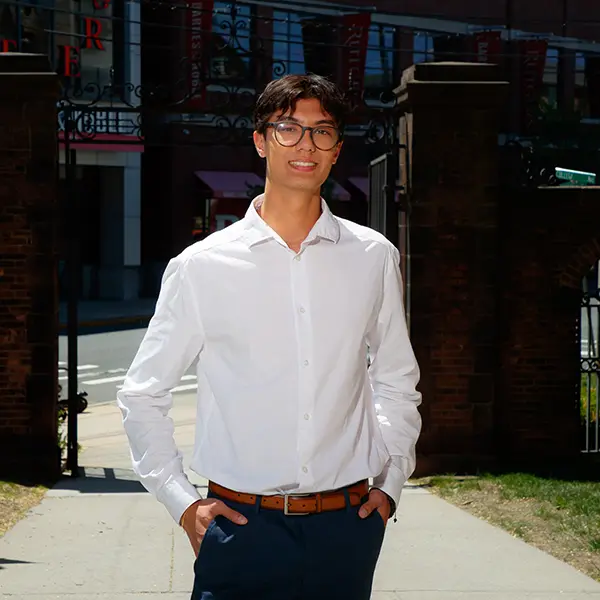From Simulations to Cityscapes: Designing Smarter Cities
Matthew L. D’Agostino
Urban Planning and Design, Class of 2025 /
Master of City and Regional Planning Class of 2026
- Minor: Architecture Studies
- Graduate Concentration: Smart Cities, Urban Informatics, and Environmental Planning
- Hometown: Newton, Ma.
- Activities at Rutgers: Graduate President, EJB|DESIGNS
For Matthew D’Agostino, it all started with a view, standing at the window of his mom’s 14th-floor office in Boston, watching the city’s rush hour unfold below.
“I was fascinated by how cities function,” he said. “I started questioning why roads were designed a certain way, how people moved through the city, and what could make urban spaces more efficient and livable.”
“When I traveled, I noticed the impact of poor design on traffic and accessibility. Sketching skylines also contributed to my love for urban environments. As I got older, I became increasingly aware of the social and environmental challenges tied to urban design. All of my experiences led me to a major where I could combine creativity, problem-solving, and a vision for better cities into something tangible.”
That curiosity sparked what would become a lifelong interest in transportation and city planning. He took to digital simulations like Intersection Controller, recreating Boston’s road networks, tweaking intersections, and designing transit systems, skills that would one day influence real-world planning decisions. “What started as a fun challenge soon became an obsession,” he said, “one that taught me the complexity of urban systems and fueled my drive to create real-world solutions for better, more sustainable cities.”
Now a senior majoring in urban planning and design with a minor in architecture studies, Matthew came to Rutgers for its strong academic program that aligned with his interests in transportation, smart cities, sustainability, and urban innovation, as well as its proximity to urban centers. “Rutgers has given me the chance to blend the technical side of planning with creative design,” he said. “I was drawn to the research opportunities, extracurriculars, and professional connections that I knew would help me grow. It’s been everything I hoped for, and more.”
Matthew quickly found his community at the Bloustein School. Through courses, field trips, research, and involvement with EJB|DESIGNS, he’s built a network of support and opportunities.
“The university has challenged me academically and helped me focus on the things that genuinely excite me,” he said. “I’ve grown a lot, not just as a student, but as a future planner.”
One course in particular,
Designing Healthy Cities with Professor Kelcie Ralph, shifted his perspective. “It challenged me to think about how we could create environments that foster physical and mental well-being,” he said.
A class project designing triangular green canopies to reduce urban flooding combined his interests in sustainability, innovation, and inclusive design. “It helped me realize the value of blending creativity with practicality, something I want to continue in my future work.”
His summer internship at HDR Engineering’s Boston office gave him a front-row seat to major transit projects around the country, including the Austin Light Rail and Santa Ana Streetcar. “That experience showed me how data, policy, and design collide in real-world planning,” he said. “It was the first time I saw how the big-picture ideas we talk about in class, equity, climate adaptation, innovation, play out through the details of a project brief or data dashboard.”
Now enrolled in the Bloustein School’s 3-1-1 program, Matthew will pursue a Master’s in City and Regional Planning with a concentration in Smart Cities, Urban Informatics, and Environmental Planning. “This aligns perfectly with my passion for using technology and sustainable practices to shape the cities of the future,” Matthew noted.
“I hope to start my career in New York City. The city’s diverse urban landscape and its push for innovative, sustainable development in transportation, infrastructure, and technology make it the ideal place for me to contribute to real-world urban planning solutions. I am excited about the potential to work with forward-thinking teams that tackle the challenges of building smarter, more sustainable cities.”
He advises students considering urban planning and design to embrace curiosity and be open to diverse perspectives. “Urban planning is a multidisciplinary field, and the ability to collaborate with people from different backgrounds, such as engineers, architects, environmental scientists, and policy experts, will enrich your learning and the solutions you develop,” he said. “Do not be afraid to ask questions, dive deep into complex urban issues, and challenge traditional ideas.”
In his free time, Matthew often explores cities on foot or by transit, observing how urban design and planning influence public spaces and shape public life. He also sketches and models ideas for future cityscapes and stays active with running, pickleball, and Nordic skiing.
“Getting outdoors is how I reset,” he said. “Whether I’m racing down a trail or enjoying a casual rally on the pickleball court, these activities keep me grounded and give me space to think through new ideas or reflect on bigger questions about cities and people.”

